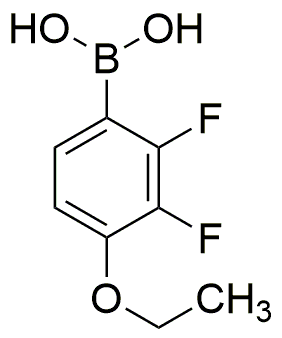4-Ethoxy-2,3-difluorophenylboronic acid is widely utilized in research focused on:
- Pharmaceutical Development: This compound serves as a key intermediate in the synthesis of various pharmaceuticals, particularly in the development of targeted cancer therapies, enhancing drug efficacy and specificity.
- Organic Synthesis: It is employed in cross-coupling reactions, such as Suzuki-Miyaura coupling, allowing chemists to create complex organic molecules efficiently, which is essential in materials science and agrochemicals.
- Bioconjugation: The boronic acid functionality enables selective binding to diols, making it useful in bioconjugation techniques for drug delivery systems and diagnostic applications, improving the precision of targeting in biological systems.
- Material Science: This compound can be used to modify surfaces and create functional materials, such as sensors and catalysts, which are crucial in developing advanced technologies for electronics and environmental applications.
- Research in Chemical Biology: It plays a role in studying protein interactions and cellular processes, providing insights into biochemical pathways and potential therapeutic targets, thus aiding in the advancement of biomedical research.
General Information
Properties
Safety and Regulations
Applications
4-Ethoxy-2,3-difluorophenylboronic acid is widely utilized in research focused on:
- Pharmaceutical Development: This compound serves as a key intermediate in the synthesis of various pharmaceuticals, particularly in the development of targeted cancer therapies, enhancing drug efficacy and specificity.
- Organic Synthesis: It is employed in cross-coupling reactions, such as Suzuki-Miyaura coupling, allowing chemists to create complex organic molecules efficiently, which is essential in materials science and agrochemicals.
- Bioconjugation: The boronic acid functionality enables selective binding to diols, making it useful in bioconjugation techniques for drug delivery systems and diagnostic applications, improving the precision of targeting in biological systems.
- Material Science: This compound can be used to modify surfaces and create functional materials, such as sensors and catalysts, which are crucial in developing advanced technologies for electronics and environmental applications.
- Research in Chemical Biology: It plays a role in studying protein interactions and cellular processes, providing insights into biochemical pathways and potential therapeutic targets, thus aiding in the advancement of biomedical research.
Documents
Safety Data Sheets (SDS)
The SDS provides comprehensive safety information on handling, storage, and disposal of the product.
Product Specification (PS)
The PS provides a comprehensive breakdown of the product’s properties, including chemical composition, physical state, purity, and storage requirements. It also details acceptable quality ranges and the product's intended applications.
Certificates of Analysis (COA)
Search for Certificates of Analysis (COA) by entering the products Lot Number. Lot and Batch Numbers can be found on a product’s label following the words ‘Lot’ or ‘Batch’.
*Catalog Number
*Lot Number
Certificates Of Origin (COO)
This COO confirms the country where the product was manufactured, and also details the materials and components used in it and whether it is derived from natural, synthetic, or other specific sources. This certificate may be required for customs, trade, and regulatory compliance.
*Catalog Number
*Lot Number
Safety Data Sheets (SDS)
The SDS provides comprehensive safety information on handling, storage, and disposal of the product.
DownloadProduct Specification (PS)
The PS provides a comprehensive breakdown of the product’s properties, including chemical composition, physical state, purity, and storage requirements. It also details acceptable quality ranges and the product's intended applications.
DownloadCertificates of Analysis (COA)
Search for Certificates of Analysis (COA) by entering the products Lot Number. Lot and Batch Numbers can be found on a product’s label following the words ‘Lot’ or ‘Batch’.
*Catalog Number
*Lot Number
Certificates Of Origin (COO)
This COO confirms the country where the product was manufactured, and also details the materials and components used in it and whether it is derived from natural, synthetic, or other specific sources. This certificate may be required for customs, trade, and regulatory compliance.


